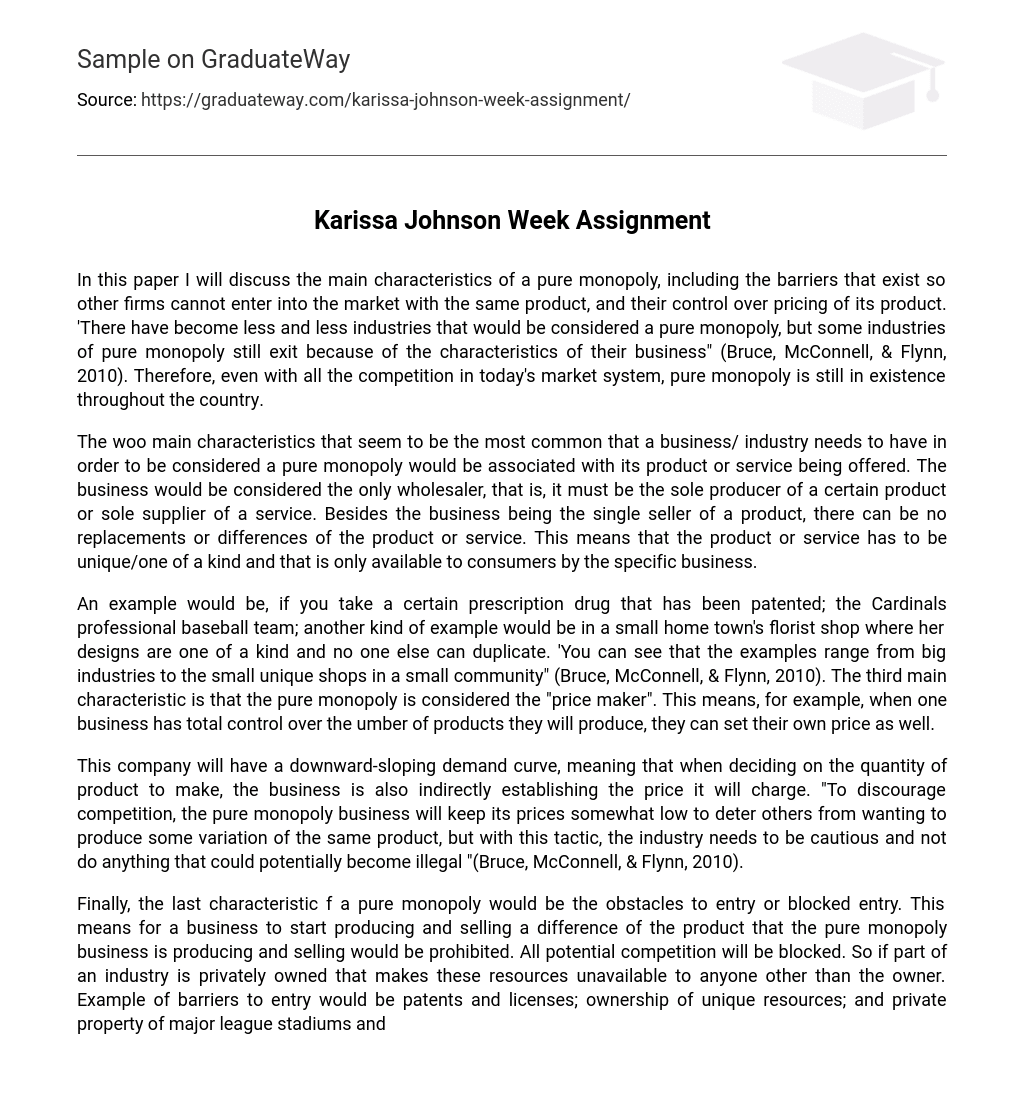In this paper I will discuss the main characteristics of a pure monopoly, including the barriers that exist so other firms cannot enter into the market with the same product, and their control over pricing of its product. ‘There have become less and less industries that would be considered a pure monopoly, but some industries of pure monopoly still exit because of the characteristics of their business” (Bruce, McConnell, & Flynn, 2010). Therefore, even with all the competition in today’s market system, pure monopoly is still in existence throughout the country.
The woo main characteristics that seem to be the most common that a business/ industry needs to have in order to be considered a pure monopoly would be associated with its product or service being offered. The business would be considered the only wholesaler, that is, it must be the sole producer of a certain product or sole supplier of a service. Besides the business being the single seller of a product, there can be no replacements or differences of the product or service. This means that the product or service has to be unique/one of a kind and that is only available to consumers by the specific business.
An example would be, if you take a certain prescription drug that has been patented; the Cardinals professional baseball team; another kind of example would be in a small home town’s florist shop where her designs are one of a kind and no one else can duplicate. ‘You can see that the examples range from big industries to the small unique shops in a small community” (Bruce, McConnell, & Flynn, 2010). The third main characteristic is that the pure monopoly is considered the “price maker”. This means, for example, when one business has total control over the umber of products they will produce, they can set their own price as well.
This company will have a downward-sloping demand curve, meaning that when deciding on the quantity of product to make, the business is also indirectly establishing the price it will charge. “To discourage competition, the pure monopoly business will keep its prices somewhat low to deter others from wanting to produce some variation of the same product, but with this tactic, the industry needs to be cautious and not do anything that could potentially become illegal “(Bruce, McConnell, & Flynn, 2010).
Finally, the last characteristic f a pure monopoly would be the obstacles to entry or blocked entry. This means for a business to start producing and selling a difference of the product that the pure monopoly business is producing and selling would be prohibited. All potential competition will be blocked. So if part of an industry is privately owned that makes these resources unavailable to anyone other than the owner. Example of barriers to entry would be patents and licenses; ownership of unique resources; and private property of major league stadiums and arenas. Other barriers could be that the company would cut prices significantly, increase advertisement of their product, or take other adverse steps to keep the barriers in place so other business would not be able to afford making this particular product” (Bruce, McConnell, & Flynn, 2010). Just because the company is considered a pure monopoly does not give any company the right to not follow the laws and regulations set up by the United States government. The basis of the anticipation law is the Sherman Act of 1 890, which states that any business dealings that are unreasonably gained or unreasonably maintained are punishable under this act.
If a pure monopoly is found guilty, the government can issue sanctions to prohibit monopolistic behavior or if deemed necessary can break up monopolies into competing firms. Our nation’s court systems can even fine and imprison any violators of the antitrust law. “Also injured parties can even sue monopolies for ‘treble damages”, which means an award of three times the amount of the financial injury done to them” (Bruce, McConnell, & Flynn, 2010). Even with the antitrust laws and regulations put into place, pure monopolies still exist and are not being deterred from being in business.
Even in today’s market system, pure monopolies do exit. As discussed, the main characteristics of a pure monopoly are: that the business is a single seller; there are no product substitutions allowed; the monopoly controls the total number of supplies produced and therefore has significant control over price of the product, also known as the price maker; and blocked entry, which raises certain barriers to keep rival companies from entering into the industry are important to remember because if one characteristic is not followed the business would not be considered a pure monopoly.





